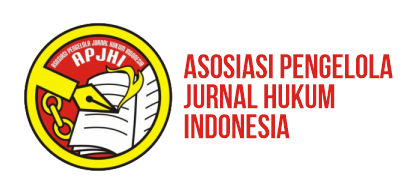Interpretation of Interfaith and/or Belief Marriage by Judges: Disparity and Legal Vacuum
Penafsiran Perkawinan Beda Agama dan/atau Kepercayaan Oleh Hakim: Disparitas dan Kekosongan Hukum
DOI:
https://doi.org/10.31078/jk2039Keywords:
Disparity, Legal Vacuum, Marriage of Different BeliefsAbstract
Judges experience disparities in interpreting marriages of different beliefs and/or religions, resulting in different legal products, both determinations made. There is a difference between granting and rejecting. Interestingly, the understanding of the Constitutional Court judges and judges at District Courts has a significant disparity where one says there is a legal vacuum and the other is clear in accordance with the law. This study concerning a disparity in interfaith marriages in its determination and the legal vacuum of different-faith marriages created by judges in court. This study concludes that in practice judges in court in giving considerations believe there is a legal vacuum against marriages of different beliefs, as a result judges determine whether there is a disparity determination that is granted or not. The Constitutional Court itself interprets its decisions (2014 and 2022) that interfaith marriages are clear and do not constitute a legal vacuum in its enforcement.
References
Adon, Mathias Jebaru. “Perkawinan Lili di Manggarai.” Dharmasmrti: Jurnal Ilmu Agama dan Kebudayaan 21, no. April (2021): 40–52.
Aprianto, Tri Chandra. “Aturan Dipersimpangan Jalan : Perdebatan Rancangan Undang-Undang (RUU) Perkawinan 1973-1994.” Historia : Jurnal Ilmu Sejarah 1, no. 1 (22 Maret 2018): 41–57. https://jurnal.unej.ac.id/index.php/JH/article/view/13507.
Arfina, Lydya, dan Anjar Sri Ciptorukmi Nugraheni. “PERKAWINAN AGAMA MENURUT HUKUM KELUARGA DI INDONESIA.” Jurnal Privat Law 7, no. 1 (1 Februari 2019): 7–12. https://doi.org/10.20961/privat.v7i1.29960.
Arifin, Zainal. “Perkawinan Beda Agama.” Jurnal Lentera, Kajian Keagamaan, Keilmuan dan Teknologi 18, no. 1 (2019): 144–45. https://doi.org/10.46362/jrsc.v4i1.126.
Aristo Evandy A.Barlian, dan Annisa D. Permata Herista. “Pembangunan Sistem Hukum Indonesia Berdasarkan Nilai-Nilai Pancasila Sebagai Ideologi Politik Bangsa.” Jurnal Lemhannas RI 9, no. 1 (31 Maret 2021): 88–98. https://doi.org/10.55960/jlri.v9i1.379.
Arsal, Arsal. “Beda Agama di Indonesia (Kajian Sejarah Sosial Hukum Islam).” Alhurriyah Jurnal Hukum Islam 14, no. 1 (2003): 38–58.
Dahwal, Sirman. “Pelaksanaan Perkawinan Beda Agama (Studi Berbagai Kasus Di Indonesia Periode Tahun 1986 - 2010).” Universitas Brawijaya, 2012. http://repository.ub.ac.id/id/eprint/160932.
Dimyati, Khudzaifah, Absori Absori, Kelik Wardiono, dan Fitrah Hamdani. “Morality and Law: Critics upon H.L.A Hart’s Moral Paradigm Epistemology Basis based on Prophetic Paradigm.” Jurnal Dinamika Hukum 17, no. 1 (2 Mei 2017): 23–30. https://doi.org/10.20884/1.jdh.2017.17.1.823.
Elviandri. “Hukum transendental dalam konstelasi pemikiran hukum positivistic di Indonesia.” Jurnal Yustisia Merdeka 2, no. 1 (2016): 30–34.
Gulo, Nimerodi. “Disparitas Dalam Penjatuhan Pidana.” Masalah-Masalah Hukum 47, no. 3 (2018): 215–27. https://doi.org/10.14710/mmh.47.3.2018.215-227.
Harapah, Burhanudin, Solikhah Muslich Sugiyono, dan Luthfiyah Trini Hastuti. “NON SECULARIZATION OF MARRIAGE LEGAL PROCEDURE BASED ON BELIEF IN ONE ALMIGHTY GOD IN INDONESIA.” Yustisia Jurnal Hukum 9, no. 2 (30 Agustus 2020): 243–61. https://doi.org/10.20961/yustisia.v9i2.27394.
Hasan, Djuhaendah. Hukum Keluarga, Setelah Berlakunya UU No. 1/1974 (Menuju Ke Hukum Keluarga Nasional). Bandung: Armico, 1988.
Indrayanti, Kadek Wiwik. “Perlindungan Hukum Bagi Warga Negara Indonesia Yang Melakukan Perkawinan Beda Agama ( Kajian Pluralisme Hukum).” Universitas Brawijaya, 2017. http://repository.ub.ac.id/id/eprint/792.
Kadriah, Kadriah, Teuku Saiful, dan Muhammad Naufal Hidayat. “Interreligous Marriage According to Indonesian Legislation.” In Proceedings of the 1st International Conference on Law and Human Rights 2020 (ICLHR 2020), 462–68, 2021. https://doi.org/10.2991/assehr.k.210506.060.
Katz, June S., dan Ronald S. Katz. “The New Indonesian Marriage Law: A Mirror of Indonesia’s Political, Cultural, and Legal Systems.” The American Journal of Comparative Law 23, no. 4 (1975). https://doi.org/10.2307/839240.
Laela, Ana, Ken Ismi Rozana, dan Shilfa Khilwiyatul Mutiah. “Fiqh Perkawinan Beda Agama sebagai Upaya Harmonisasi Agama (Studi Perkawinan Beda Agama di Kota Jember).” Fikrah 4, no. 1 (30 Juni 2016): 117–37. https://doi.org/10.21043/fikrah.v4i1.1627.
Lemmings, David. “Marriage and the law in the eighteenth century: Hardwicke’s Marriage Act of 1753.” The Historical Journal 39, no. 2 (11 Juni 1996): 339–60. https://doi.org/10.1017/S0018246X00020276.
Mahkamah Agung Republik Indonesia. Penetapan Pengadilan Negeri Bekasi Nomor 211/Pdt.P/2019/PN. Bks (2019).
Mahkamah Agung Republik Indonesia. Penetapan Pengadilan Negeri Blora Nomor 71/Pdt.P/2017/PN (2017).
Mahkamah Agung Republik Indonesia. Penetapan Pengadilan Negeri Denpasar Nomor 878/Pdt.P/2019/PN Dps (2019).
Mahkamah Agung Republik Indonesia. Penetapan Pengadilan Negeri Surabaya Nomor 916/Pdt.P/2022/PN. Sby (2022).
Mahkamah Agung Republik Indonesia. Penetapan Pengadilan Negeri Surakarta Kelas 1A Nomor 403/Pdt.P/2019/PN Skt (2019).
Mahkamah Agung Republik Indonesia. Penetapan Pengadilan Negeri Surakarta Nomor 333/Pdt.P/2018/PN. Skt (2018).
Mahkamah Agung Republik Indonesia. Putusan Mahkamah Agung Nomor 1400K/PDT/1986 (1986).
Mahkamah Konstitusi Republik Indonesia. Putusan Mahkamah Konstitusi Nomor 24/PUU-XX/2022 (2022).
Mahkamah Agung Republik Indonesia. Putusan Mahkamah Konstitusi Nomor 68/PUU-XII/2014 (2014).
Marzuki, Peter. “Penelitian Hukum,.” jurnal Penelitian Hukum, 2011.
Milati Fatma Sari, Mulyadi, Yutanto. “Analisis Putusan Judicial Review Mahkamah Konstitusi Putusan No. 68/PUU-XII/2014 Atas Pasal 2 Ayat (1) Undang-Undnag No. 1 Tahun 1974 Terhadap Perkawinan Beda Agama.” Diponegoro Law Journal 5, no. 3 (2016): 1-11.
Nasir, Gamal Abdul. “Kekosongan Hukum & Percepatan Perkembangan Masyarakat.” Jurnal Hukum Replik 5, no. 2 (1 September 2017): 172–83. https://doi.org/10.31000/jhr.v5i2.925.
Noormansyah, Andra, dan Umar Haris Sanjaya. “The Legal Vacuum Of Interreligious Marriage In Indonesia: The Study Of Judges’ Consideration In Interreligious Marriage Court Decisions 2010 -2021.” Prophetic Law Review 4, no. 2 (1 Desember 2022): 177–94. https://doi.org/10.20885/PLR.vol4.iss2.art3.
Opwis, Felicitas. “Maslaha in Contemporary Islamic Legal Theory.” Islamic Law and Society 12, no. 2 (2005): 182–223. https://doi.org/10.1163/1568519054093699.
Pratama, Fachrizza Sidi. “Fenomena Rechtsvacuum Dalam Peraturan Pemerintah Republik Indonesia Nomor 51 Tahun 2020 Terkait Masa Perpanjang Paspor Menjadi 10 Tahun.” Journal of Law and Border Protection 1, no. 1 (28 Mei 2019): 51–58. https://doi.org/10.52617/jlbp.v1i1.156.
Sanjaya, Umar Haris, dan Karimatul Ummah. “The Challenge of Using the Transcendental Principle in the Law of Marriage in Indonesia.” Jurnal Magister Hukum Udayana (Udayana Master Law Journal) 12, no. 2 (2023): 314–29. https://ojs.unud.ac.id/index.php/jmhu/article/view/86405.
Setiyowati, Setiyowati. “Recent Changes in Regulatory Development of Interreligious Marriage and Children’s Rights Based on Justice Perspective in Indonesia.” International Journal of Criminology and Sociology 10, no. 1 (14 Juli 2021): 1149–53. https://doi.org/10.6000/1929-4409.2021.10.133.
Sukirno, Sukirno. “Diskriminasi Pemenuhan Hak Sipil Bagi Penganut Agama Lokal.” Administrative Law and Governance Journal 1, no. 3 (5 Desember 2018): 231–39. https://doi.org/10.14710/alj.v1i3.231-239.
Sutiyoso, Bambang. “Pembentukan Mahkamah Konstitusi Sebagai Pelaku Kekuasaan Kehakiman di Indonesia.” Jurnal Konstitusi 7, no. 6 (20 Mei 2016): 025–050. https://doi.org/10.31078/jk762.
Downloads
Published
How to Cite
Issue
Section
License
Copyright (c) 2023 Jurnal Konstitusi

This work is licensed under a Creative Commons Attribution-NonCommercial-ShareAlike 4.0 International License.
Authors who publish with this journal agree to the following terms:
- Copyright of the published articles will be transferred to the journal as the publisher of the manuscripts. Therefore, the author confirms that the copyright has been managed by the publisher.
- The publisher of Jurnal Konstitusi is The Registrar and Secretariat General of the Constitutional Court of the Republic of Indonesia.
- The copyright follows Creative Commons Attribution-NonCommercial-ShareAlike 4.0 International License: This license allows reusers to distribute, remix, adapt, and build upon the material in any medium or format for noncommercial purposes only, and only so long as attribution is given to the creator. If you remix, adapt, or build upon the material, you must license the modified material under identical terms.

















